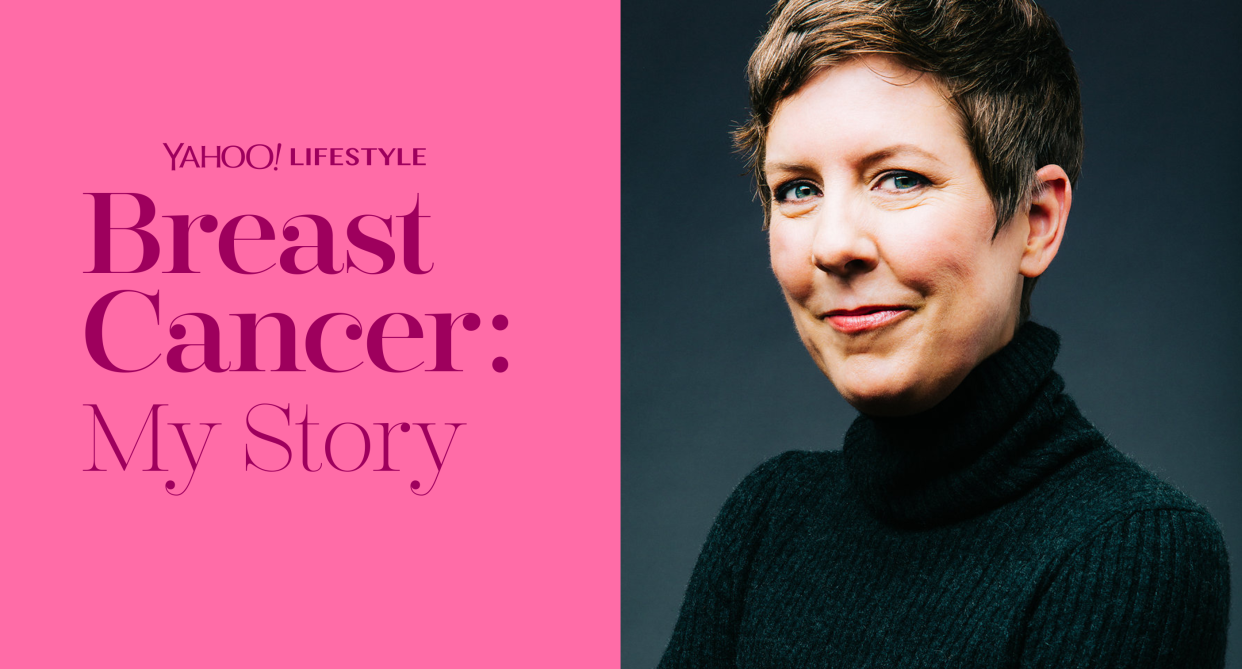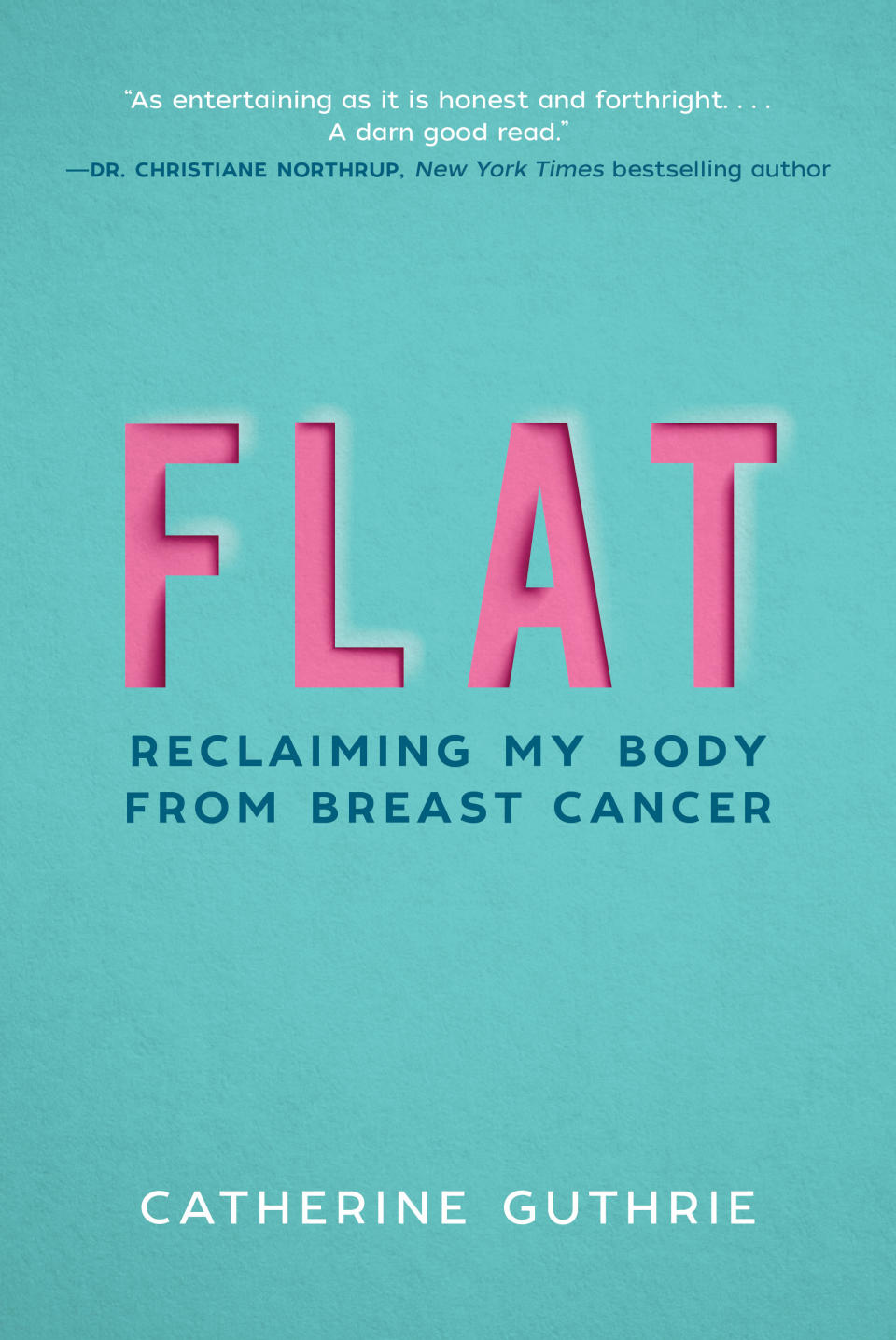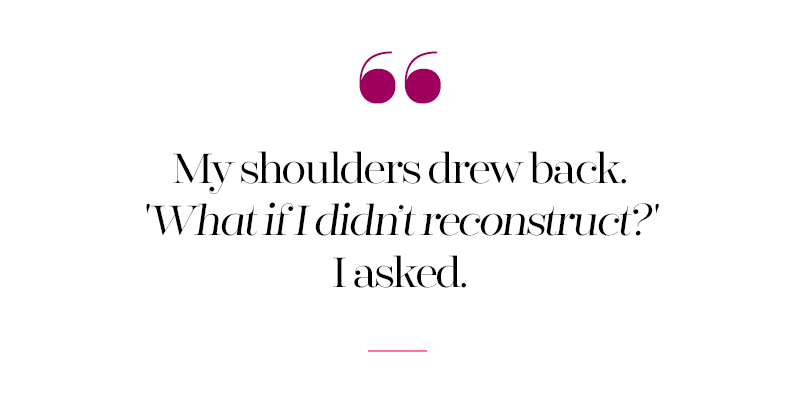Why I chose to 'go flat' after my mastectomy

In honor of Breast Cancer Awareness Month, in October, Yahoo Lifestyle will be publishing first-person accounts of those who have been affected by the disease, which will be responsible for the deaths of an estimated 40,920 women (and nearly 500 men) this year. All women have about a 1 in 8 lifetime risk of developing some form of the breast cancer. Awareness, screenings, and early detection can save lives.
The following is excerpted from FLAT: Reclaiming My Body From Breast Cancer by Catherine Guthrie (Sept. 25) with permission from Skyhorse Publishing, Inc.
Back at the IU Simon Cancer Center, Mary and I waited to meet the plastic surgeon, Dr. V. The exam room was small, windowless, and relentlessly beige. Sitting on the table, I shivered under the paper gown, thankful for the warmth of my jeans, wool socks, and winter boots.
In the corner, Mary colonized the hard plastic “guest” chair. She wiped her glasses clean and pulled her notebook and a thin black Sharpie out of her worn backpack. She’d come straight from class and still wore one of her teaching outfits—smooth gray pants and a burgundy sweater with a tailored dress shirt underneath, the cuffs neatly rolled up past her wrists. She ran her fingers through her bangs, brushing them away from her eyes. Her chestnut-brown hair was overgrown, almost long enough to tuck behind her ears. She glanced up at me and feigned a smile. “You ready for this?” she asked.

Flames licked at my hairline.
My body shifted on the padded table and a small roll of belly fat heaved over the waistband of my jeans as if vying for the plastic surgeon’s attention.
But his eyes stayed on my breasts. Would he notice the left was a smidgen bigger than the right? The day before, Mary had joked that a lumpectomy might even me out. “After all, leftie does have a little to spare.”
More than once, Mary had called my breasts “the perfect handful,” and I liked how well suited they were for my small frame. The size of peaches, they were unobtrusive enough for me to go bra-less under winter sweaters. And during the summer, a simple, minimally struc-tured bra did the trick.
After what felt like forever, Dr. V drew the gown closed across my chest, a curtain falling on a stage.
“I’m afraid a lumpectomy is out of the question.”
“Excuse me?”

Three surgeons—two breast surgeons and a general surgeon—had assured me a lumpectomy would take care of it. But the plastic surgeon, the person responsible for the end result, had the final say.
“A lumpectomy would decimate your breast.”
The word decimate hung in the air between us.
Decimate sounded both vague and specific.
Hurricanes decimated coastal communities.
Earthquakes decimated cities.
There was no room in my neat-and-clean, worm-and-apple breast cancer metaphor for the word decimate.
A hollow space opened up behind my ribs, as if all the soft parts of my body had deflated like spent balloons. My breathing was shallow, my armpits slicked with sweat.
He explained that the location of my lump (high) and the size of my breast (small) meant I wasn’t a candidate for a lumpectomy.
And just like that the most sensible and least-invasive treatment option was off the table.
He said a single mastectomy with reconstruction would be best. The reconstructive surgery best suited to my body was a latissimus flap, named for the back muscle (latissimus dorsi) that he would sever and use to fashion a new breast. He explained how he would carve apart the largest muscle in my back, and, with one end of the muscle connected to its blood supply, tunnel the loose end (the flap) through my body and under my arm until it reached the empty socket on my chest where my breast had been. Then he would pull the flap of muscle up and over a silicone implant. I pictured a steak laid over a tennis ball.
“Isn’t that muscle doing something?” I asked.
“Most women hardly miss it,” he said, his eyes on his notes.
Most women?
“Most women just want to look normal in clothes,” he added, still not looking up.
Normal?
“You’re not an athlete, are you?” At last, he glanced up from his clipboard.
I wanted to tell him about my yoga practice, how I’d spent years learning to trust my body’s wisdom. Learning to overcome the quick-sand of my fear. The real fear of falling. The irrational fear of snapping the metal rod that fused my lumbar spine. I wanted to tell him that yoga was where I’d made peace with my body. I wanted to tell him that my favorite pose was handstand, how I’d spent five years working up the confidence and the strength to put my hands on my mat and kick my legs to the sky. How hugging my upper back muscles into my vertical axis and balancing my weight on my hands made me feel strong and powerful in a world filled with messages telling me I was weak and in need of protection.
Instead, I answered, “Um, no, but . . .”

Dr. V explained how the skin of my chest could be stretched to make room for a breast implant. He’d wedge a tissue expander into the flat plane between my ribs and my chest muscle. Once a week for a few months, I’d visit his office where saline would slowly be injected into the inflatable device. As it expanded, it would tug, stretch, and coerce my chest muscle up and away from its moorings. Once the process was complete, he would operate to swap the tissue expander for an implant.
Goosebumps prickled up the backs of my arms. What would it feel like to have my pectoral muscle slowly ripped from its foundation? I pictured the KFC I’d eaten as a kid. The way my front teeth pulled the chicken’s breast meat from the bone. The sound of its connective tissue tearing. The sight of those scrawny, matchstick-thin ribs under-neath.
“Of course, matching a new breast to your existing breast is almost impossible.” He explained that an implant would have a different shape and feel. “So we could put an implant in your other breast, too. You know, for symmetry. Insurance companies will usually cover surgery on the healthy breast, especially in women your age.”
My mind raced to catch up. In less than an hour, my anticipated lumpectomy had escalated into two breast implants, a tissue expander, a harvested muscle from my back, and at least two surgeries, maybe more.
He paused.
Acid from my stomach sloshed at the base of my throat.
“Is there any other way? Something that doesn’t involve implants and rearranging muscles?”
The question sounded childish. Why was I so peevish, so maladap-tive that I couldn’t get with the program?
Plus, there was another consideration. My scoliosis still caused my spine to curve, which meant my back was in a chronic state of torque and imbalance. Could it handle the loss of a key support beam? Was he even going to ask about pre-existing conditions? Prior surgeries?
A flood of panic rose in my lungs. The string of my hospital gown was wound around the tip of my index finger, and the skin had turned white.
Mary leaned forward in her chair, elbows on knees, her black note-book pressed between the cool of her palms. “Isn’t there some other way?”
“Look,” Dr. V said. He sighed, ran his hands through his hair, took a wider stance. The soles of his shoes squeaked on the linoleum. “If I do a lumpectomy, your breast will no longer look like a breast.”
What about other reconstructive surgeries? Ones that used a woman’s own tissue. Fat and muscle harvested from the belly, buttocks, or thighs, molded into a breastlike shape and grafted onto the chest. Native tissue looked more natural than an implant, and, unlike implants, it didn’t need to be replaced. The downsides were significant. The surgery was much longer (six to seven hours) and the recovery much more painful, requiring several days in the intensive care unit and at least a week in the hospital.
“You’re not a candidate for those procedures either,” he said. “You are too thin. You don’t have enough fat to make a new breast.”
Did he just say I wasn’t fat enough for a new breast?
Like most women, I’d been taught to equate thinness with femi-ninity. Yes, I’d inherited my mother’s high metabolism, but I kept one eye on my waistline. What woman hadn’t? Now, Dr. V was telling me I was too thin for new breasts. By succeeding at one marker of femi-ninity, I had positioned myself to fail at another.
My shoulders drew back.
“What if I didn’t reconstruct?” I asked.
The final “t” sounded crisp and curt, more indicative of bravado than confidence.
I don’t remember exactly how he answered me. But I do remember his inference that I’d be foolish to pass up the chance to get the breasts I’d “always wanted,” as if all women pine for an upgrade.

Read more from Yahoo Lifestyle:
Follow us on Instagram, Facebook, and Twitter for nonstop inspiration delivered fresh to your feed, every day.
